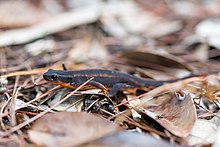Swordtail newt
| Swordtail newt | ||||||||||||
|---|---|---|---|---|---|---|---|---|---|---|---|---|

Swordtail newt ( Cynops ensicauda popei ) |
||||||||||||
| Systematics | ||||||||||||
|
||||||||||||
| Scientific name | ||||||||||||
| Cynops ensicauda | ||||||||||||
| ( Hallowell , 1861) |
The sword tail pig ( Cynops ensicauda ) is a salamander from the kind of fire belly newts ( Cynops ). It occurs on some islands in the Japanese archipelago.
features
The swordtail newt is a medium-sized, stocky-looking water newt whose females can be 15 to 16 centimeters long. 19 cm long specimens have also been reported. The top is colored dark brown to black; there is often a yellowish longitudinal stripe on the sides, which can be interrupted. There are also many bright spots there. The skin appears grained. The ventral side is usually yellow to orange in color. A glandular ridge runs down the middle of the back and there are bulges on the side of the torso, but only in the front part. These contain a poisonous skin secretion to ward off predators. The tail is narrow-oval in cross-section. During the stay in the water, the tail edges widen.
distribution and habitat
The swordtail newt ( Cynops ensicauda ) occurs in two subspecies on several southern Japanese islands of the Ryūkyū group . The nominate form Cynops ensicauda ensicauda colonizes the Amami islands Kakeromashima and Tokunoshima in the prefecture of Kagoshima . The subspecies Cynops ensicauda popei lives on the Okinawa Islands, among others on Okinawa Hontō and in the community of Kin.
Stagnant bodies of water such as weedy ponds, irrigation ditches and rice fields are preferred as habitats . Outside the breeding season in spring, the animals sometimes switch to rural life from June / July and then hide under stones and dead wood.
The food spectrum includes a wide variety of insects and their larvae , small crustaceans ( water fleas , hippos and the like) and earthworms .
Reproduction
Males in heat pursue the females, then stand across in front of them and fan these sexual fragrances by wagging their tails . Then the female follows the male, who secretes a spermatophore. This can stick to the cloaca of the female where the sperm threads are taken up. However, since there are always many more males than females nearby, the male's mating ritual is often interrupted by rivals. This results in a far lower fertilization rate than the closely related Japanese fire-bellied newt ( Cynops pyrrhogaster ).
Later the female attaches around 200 eggs in gelatinous shells to underwater plants. The eggs serve as food for numerous predators, including the newt Echinotriton andersoni , which is also native to the Ryūkyū Islands, and the snake Amphiesma pryeri . The larvae hatch after a few weeks of embryonic development and now need around three months as gill breathers to metamorphose into lung-breathing land animals. During this time the tadpoles are not only threatened by the drying up of temporary pools and puddles, but are also exposed to predators such as dragonfly larvae, larvae of the newt Echinotriton andersoni and, last but not least, larger larvae of their own species.
Danger
The species is considered endangered ("endangered"). Their habitat on some Japanese islands is only around 5000 square kilometers. This distribution area is highly fragmented. The newts are affected by the destruction of their habitat and the draining of ponds in wetlands where they lay their eggs. In addition, farmed fish such as tilapia species were also used there, which feed on the fry. On hikes during the rain, the newts often fall into concrete trenches from which they can no longer escape and dry up after the rainwater has run off.
Systematics and taxonomy
The swordtail newt was first described as Triton ensicauda by the American herpetologist Edward Hallowell in the 1861 volume of the Proceedings of the Academy of Natural Sciences of Philadelphia for the year 1860 . Later the newt was often viewed as a subspecies of the Japanese fire-bellied newt, which is common on the large Japanese islands and some offshore smaller islands, but not on the Ryūkyū Islands. However, in 1988 Hayashi and Matsui used electrophoresis methods to demonstrate that the swordtail newt is a clearly distinguishable separate species with two subspecies.
Individual evidence
- ↑ a b c Cynops ensicauda . Salamander pages, accessed May 18, 2020
- ↑ a b Terutake Hayashi & Masafumi Matsui: Biochemical differentiation in Japanese newts, genus Cynops (Salamandridae). Zoological Science, 5, pp. 1121-1136, 1988, pp. 1134.
- ↑ Peter Dollinger: Sword Tail Newt . Zoo animal lexicon, accessed on May 18, 2020.
- ↑ a b c Nichole Winters: Cynops ensicauda Sword-tailed Newt . Species Account, AmphibiaWeb 2009, University of California, Berkeley, CA, USA. Retrieved May 18, 2020.
- ↑ Cynops ensicauda in the IUCN Red List of Threatened Species 2015.4. Listed by: Kaneko & Matsui, 2004. Retrieved May 17, 2020.
- ^ E. Hallowell: Report upon the Reptilia of the North Pacific Exploring Expedition, under command of Capt. John Rogers, USN Proceedings of the Academy of Natural Sciences of Philadelphia, 12, 1861 "1860", pp. 480-510.
literature
- Edward Hallowell: Report upon the Reptilia of the North Pacific Exploring Expedition, under command of Capt. John Rogers, USN Proceedings of the Academy of Natural Sciences of Philadelphia, 12, 1861 "1860", pp. 480-510 (first description)
- RC Goris & N. Maeda: Guide to the Amphibians and Reptiles of Japan. Krieger Publishing Company, Malabar, Florida 2004.
Web links
- Darrel R. Frost: Cynops ensicaudata (Hallowell, 1861) . Amphibian Species of the World: an Online Reference, Version 6.0, American Museum of Natural History, 1998-2020, accessed May 18, 2020.
- Cynops ensicauda inthe IUCN Red List of Threatened Species 2015.4. Listed by: Kaneko & Matsui, 2004. Retrieved May 18, 2020.
